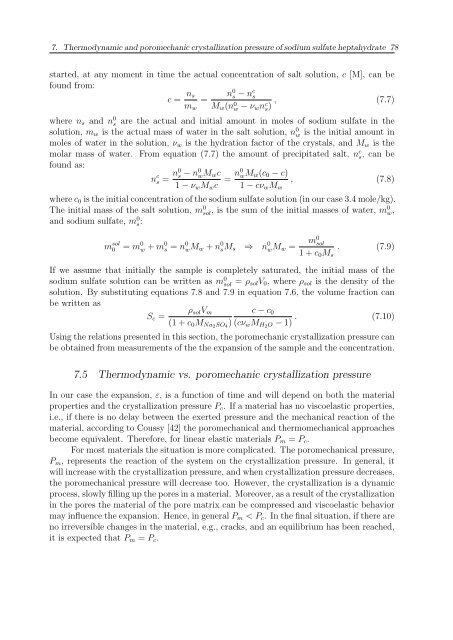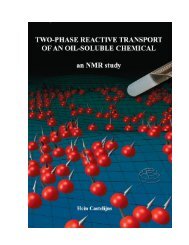P - Technische Universiteit Eindhoven
P - Technische Universiteit Eindhoven
P - Technische Universiteit Eindhoven
Create successful ePaper yourself
Turn your PDF publications into a flip-book with our unique Google optimized e-Paper software.
7. Thermodynamic and poromechanic crystallization pressure of sodium sulfate heptahydrate 78<br />
started, at any moment in time the actual concentration of salt solution, c [M], can be<br />
found from:<br />
c = n s n 0 s − n c s<br />
=<br />
m w M w (n 0 w − ν w n c s) , (7.7)<br />
where n s and n 0 s are the actual and initial amount in moles of sodium sulfate in the<br />
solution, m w is the actual mass of water in the salt solution, n 0 w is the initial amount in<br />
moles of water in the solution, ν w is the hydration factor of the crystals, and M w is the<br />
molar mass of water. From equation (7.7) the amount of precipitated salt, n c s, can be<br />
found as:<br />
n c s = n0 s − n 0 wM w c<br />
1 − ν w M w c = n0 wM w (c 0 − c)<br />
, (7.8)<br />
1 − cν w M w<br />
where c 0 is the initial concentration of the sodium sulfate solution (in our case 3.4 mole/kg).<br />
The initial mass of the salt solution, m 0 sol, is the sum of the initial masses of water, m 0 w,<br />
and sodium sulfate, m 0 s:<br />
m sol<br />
0 = m 0 w + m 0 s = n 0 wM w + n 0 sM s ⇒ n 0 wM w = m0 sol<br />
1 + c 0 M s<br />
. (7.9)<br />
If we assume that initially the sample is completely saturated, the initial mass of the<br />
sodium sulfate solution can be written as m 0 sol = ρ sol V 0 , where ρ sol is the density of the<br />
solution. By substituting equations 7.8 and 7.9 in equation 7.6, the volume fraction can<br />
be written as<br />
ρ sol V m c − c 0<br />
S c =<br />
(1 + c 0 M Na2 SO 4<br />
) (cν w M H2 O − 1) . (7.10)<br />
Using the relations presented in this section, the poromechanic crystallization pressure can<br />
be obtained from measurements of the the expansion of the sample and the concentration.<br />
7.5 Thermodynamic vs. poromechanic crystallization pressure<br />
In our case the expansion, ε, is a function of time and will depend on both the material<br />
properties and the crystallization pressure P c . If a material has no viscoelastic properties,<br />
i.e., if there is no delay between the exerted pressure and the mechanical reaction of the<br />
material, according to Coussy [42] the poromechanical and thermomechanical approaches<br />
become equivalent. Therefore, for linear elastic materials P m = P c .<br />
For most materials the situation is more complicated. The poromechanical pressure,<br />
P m , represents the reaction of the system on the crystallization pressure. In general, it<br />
will increase with the crystallization pressure, and when crystallization pressure decreases,<br />
the poromechanical pressure will decrease too. However, the crystallization is a dynamic<br />
process, slowly filling up the pores in a material. Moreover, as a result of the crystallization<br />
in the pores the material of the pore matrix can be compressed and viscoelastic behavior<br />
may influence the expansion. Hence, in general P m < P c . In the final situation, if there are<br />
no irreversible changes in the material, e.g., cracks, and an equilibrium has been reached,<br />
it is expected that P m = P c .
















